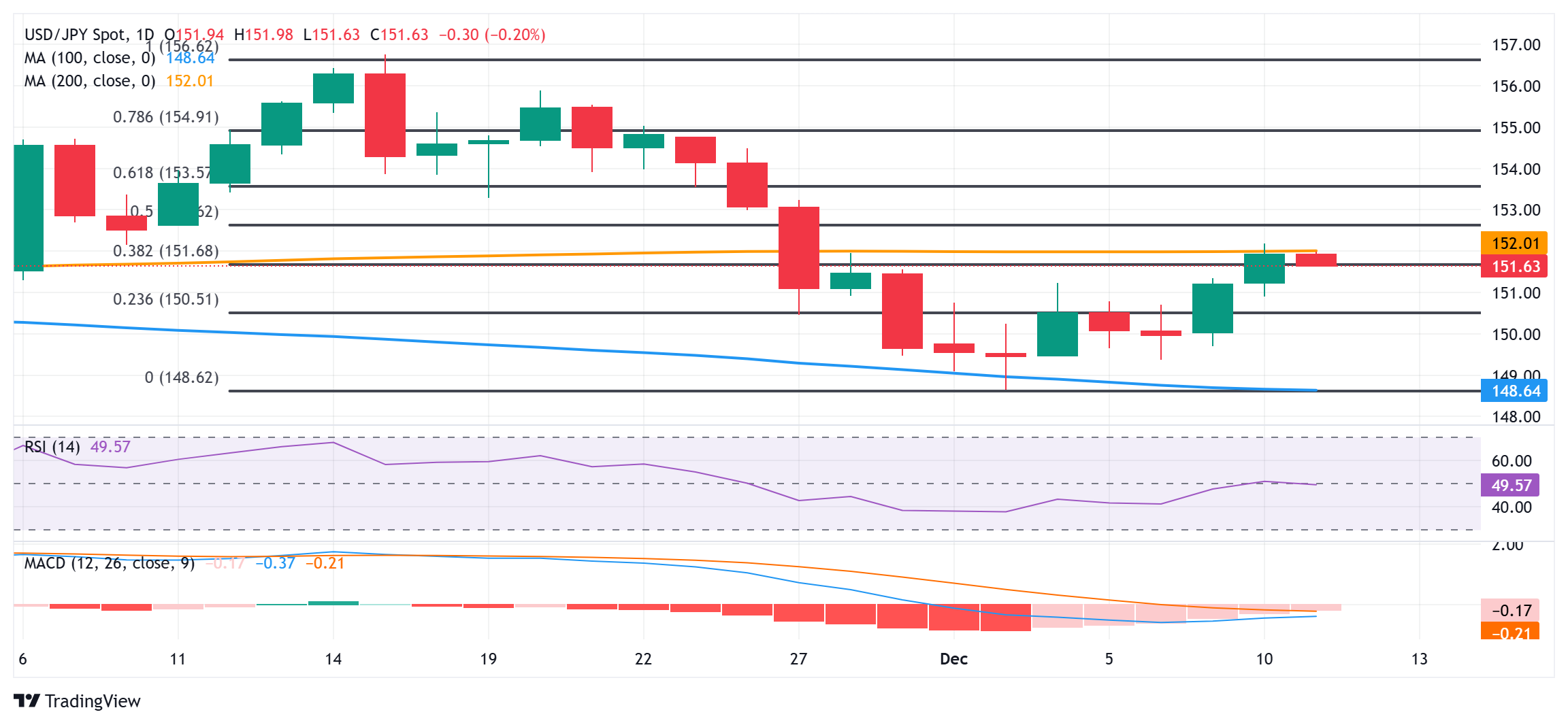Japanese Yen retains intraday positive bias; USD/JPY slides to mid-151.00s

- The Japanese Yen strengthens slightly following the release of stronger PPI print from Japan.
- The uncertainty over how soon the BoJ could raise rates keeps the JPY bulls on the defensive.
- The USD preserves its recent gains and lends support to USD/JPY ahead of the US CPI report.
The Japanese Yen (JPY) sticks to modest intraday gains through the Asian session on Wednesday, which, along with a subdued US Dollar (USD) price action, drags the USD/JPY pair away from a near two-week high touched the previous day. The JPY bulls, however, lack conviction in the wake of wavering expectations that the Bank of Japan (BoJ) will deliver an interest rate hike in December.
Adding to this, a further recovery in the US Treasury bond yields is seen as another factor acting as a headwind for the lower-yielding JPY. Moreover, expectations that the Federal Reserve (Fed) will adopt a cautious stance on cutting rates offer support to the buck and should limit the downside for the USD/JPY pair. Traders also opt to wait on the sidelines ahead of the US consumer inflation figures.
Japanese Yen remains on front foot; lacks follow-through amid BoJ rate hike uncertainty
- A preliminary report by the Bank of Japan revealed this Wednesday that Japan’s Producer Price Index (PPI) increased by 0.3% in November and rose by 3.7% compared to the same time period last year.
- This comes on top of last Friday’s wage growth figures, which showed that October base pay grew 2.7% YoY, or the fastest rate since November 1992 and gives the BoJ another reason to hike interest rates.
- Moreover, BoJ Governor Kazuo Ueda recently said that the timing of the next rate hike was approaching, though some media reports suggested the central bank may skip a rate hike later this month.
- Furthermore, BoJ’s more dovish board member Toyoaki Nakamura said last week that the central bank must move cautiously in raising rates, fueling uncertainty about the BoJ’s December policy decision.
- The US Treasury bond yields ended at their highest levels in at least a week on Tuesday on the back of growing acceptance that the Federal Reserve will adopt a cautious stance on cutting interest rates.
- The US Dollar preserves its gains registered over the past three days and offers some support to the USD/JPY pair as traders keenly await the release of the latest US consumer inflation figures later today.
- The headline US Consumer Price Index (CPI) is expected to increase to 0.3% in November as compared to 0.2% in the previous month and rise to 2.7% on a year-over-year basis from 2.6% in October.
- Meanwhile, the core gauge (excluding food and energy prices) is forecast to remain unchanged at 0.3% for November and at a 3.3% YoY rate, raising concern over lingering inflationary pressures.
- The data won’t necessarily derail expectations for a rate cut by the Fed at next week’s meeting, though would suggest fewer rate cuts coming at a slower pace than many had been anticipating.
USD/JPY dip-buying should help limit losses; the 151.00 mark holds the key for bulls
The overnight failure to find acceptance above the 152.00 mark, which coincides with the 200-day Simple Moving Average (SMA), warrants caution for bulls. Moreover, neutral oscillators on the daily chart make it prudent to wait for a sustained strength beyond the said barrier before positioning for an extension of the recent bounce from a near two-month low. The USD/JPY pair might then climb to the 152.70-152.75 region, or the 50% retracement level of the downfall from a multi-month top touched in November. This is followed by the 153.00 round figure, above which spot prices could extend the momentum towards the 61.8% Fibonacci level, around the 153.70 area.
On the flip side, weakness below the 151.55-151.50 region could be seen as a buying opportunity and find decent support near the 151.00 mark. Some follow-through selling, however, might expose the 150.00 psychological mark, with some intermediate support near the 23.6% Fibo. level, around the 150.50 area. Failure to defend the said support levels could drag the USD/JPY pair back towards the 149.55-149.50 region en route to the 149.00 round figure and 148.65 zone, or the lowest level since October 11 touched last week.
Bank of Japan FAQs
The Bank of Japan (BoJ) is the Japanese central bank, which sets monetary policy in the country. Its mandate is to issue banknotes and carry out currency and monetary control to ensure price stability, which means an inflation target of around 2%.
The Bank of Japan embarked in an ultra-loose monetary policy in 2013 in order to stimulate the economy and fuel inflation amid a low-inflationary environment. The bank’s policy is based on Quantitative and Qualitative Easing (QQE), or printing notes to buy assets such as government or corporate bonds to provide liquidity. In 2016, the bank doubled down on its strategy and further loosened policy by first introducing negative interest rates and then directly controlling the yield of its 10-year government bonds. In March 2024, the BoJ lifted interest rates, effectively retreating from the ultra-loose monetary policy stance.
The Bank’s massive stimulus caused the Yen to depreciate against its main currency peers. This process exacerbated in 2022 and 2023 due to an increasing policy divergence between the Bank of Japan and other main central banks, which opted to increase interest rates sharply to fight decades-high levels of inflation. The BoJ’s policy led to a widening differential with other currencies, dragging down the value of the Yen. This trend partly reversed in 2024, when the BoJ decided to abandon its ultra-loose policy stance.
A weaker Yen and the spike in global energy prices led to an increase in Japanese inflation, which exceeded the BoJ’s 2% target. The prospect of rising salaries in the country – a key element fuelling inflation – also contributed to the move.
